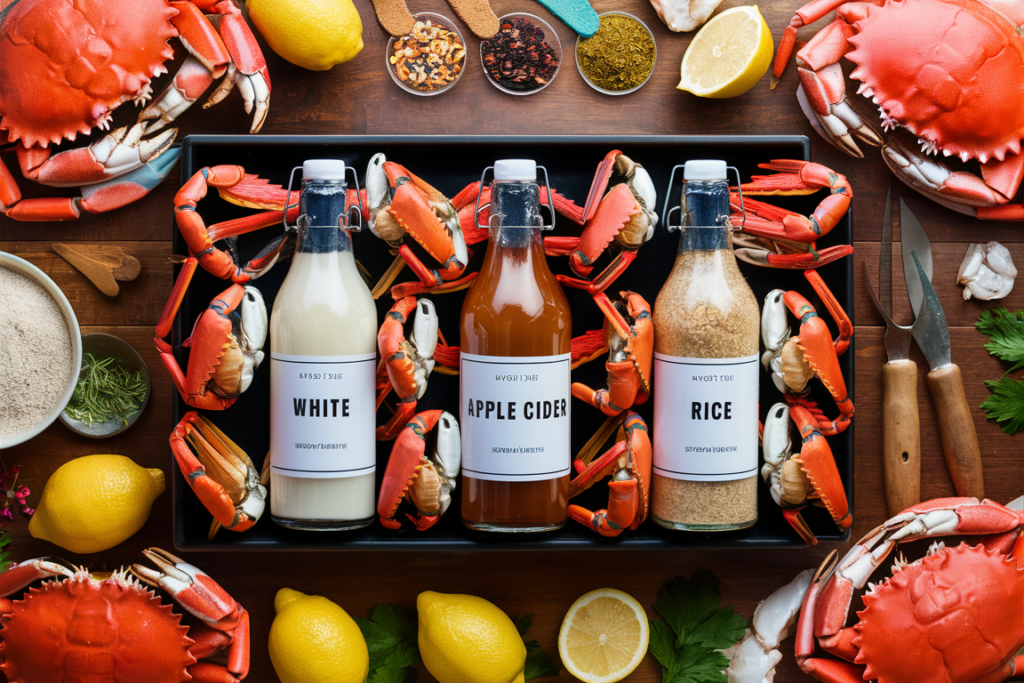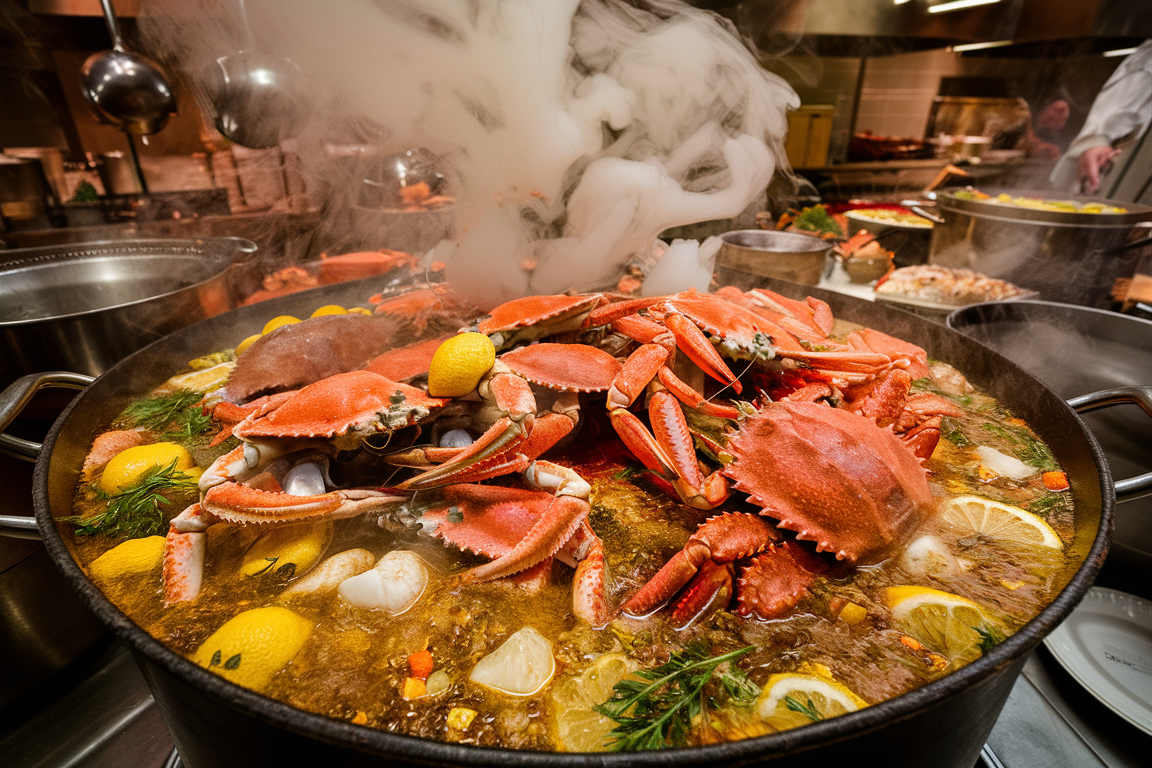Part 1: Understanding the Basics of Crab Boil
Introduction: What is a Crab Boil?
A crab boil is a traditional cooking method widely popular in coastal regions, especially in the southern United States. It involves boiling crabs with a mixture of flavorful seasonings, spices, and vegetables in a large pot of water. This technique is not just about cooking but also celebrates communal dining, as it’s often served on a large table for friends and family to enjoy together.
The popularity of crab boil stems from its bold, aromatic flavors and versatility in accommodating different regional and cultural preferences. Variations exist, such as Louisiana’s spiced boils or Maryland’s Old Bay-inspired recipes.
Components of a Crab Boil
A traditional crab boil includes:
- Crabs: Blue crabs, Dungeness, or king crabs.
- Seasonings: Old Bay, Cajun seasoning, paprika, cayenne pepper, garlic, and bay leaves.
- Aromatics: Onions, garlic, celery, and lemon halves.
- Other Ingredients: Corn, potatoes, and sausages are often added to the pot.
The seasonings and spices are critical, as they infuse the crabs with layers of flavor. Adjustments can be made to suit preferences, from milder boils to those that pack a spicy punch.
The Science of Cooking Crabs
Cooking crabs involves immersing them in boiling water, which:
- Quickly denatures the proteins, making the meat firm.
- Enhances flavors as the heat releases natural sweetness from the meat.
- Requires precise temperature control (around 212°F or 100°C) to avoid overcooking and toughening the meat.
Salt is an essential ingredient, as it mimics the natural salinity of seawater and helps preserve the crab’s delicate flavor.
What is Vinegar?
Vinegar is an acidic liquid created through the fermentation of ethanol by acetic acid bacteria. Various types of vinegar are available, each with its distinct taste and culinary applications:
- White Vinegar: Sharp and clean flavor, commonly used in pickling and cleaning.
- Apple Cider Vinegar: Fruity and tangy, often added to marinades and dressings.
- Balsamic Vinegar: Sweet and syrupy, ideal for drizzling over salads or cooked dishes.
Across cuisines, vinegar is prized for its ability to balance flavors, tenderize proteins, and preserve food. Its versatility makes it an essential pantry staple.
Adding Vinegar to Cooking Processes
Vinegar is commonly used in cooking to:
- Brighten flavors in soups and stews.
- Tenderize tough cuts of meat in marinades.
- Balance fatty or rich dishes, such as fried seafood.
In seafood preparation, vinegar plays a particularly crucial role, enhancing taste while addressing specific challenges like odor and texture.
The Role of Acidity in Cooking
Acidity profoundly influences cooking, interacting with ingredients to create unique outcomes:
- Breaks down proteins for tenderness.
- Activates flavors, providing a contrast to sweet or salty elements.
- Reacts with other ingredients to improve texture and structure.
In seafood, acidity counteracts the natural brininess and helps maintain the fresh taste of the dish.
Vinegar in Seafood Preparation
Vinegar’s role in seafood is well-documented in culinary traditions worldwide:
- In Ceviche: Citrus or vinegar cures raw fish, giving it a firm texture.
- In Marinades: It breaks down muscle fibers for tenderness.
- With Crabs and Shellfish: Vinegar enhances sweetness, neutralizes odors, and makes shells easier to crack.
Adding vinegar to a crab boil aligns with these principles, resulting in a more flavorful, aromatic, and enjoyable dish.
Part 2: Benefits of Adding Vinegar to Crab Boil
Enhancing Flavor

Vinegar’s primary contribution to a crab boil lies in its ability to enhance the natural sweetness of crab meat. Crabs, particularly blue crabs and Dungeness crabs, have a subtle sweetness that can sometimes be overshadowed by intense spices and seasonings. The acidity in vinegar:
- Balances the strong flavors of garlic, cayenne, and other spices.
- Cuts through the richness of butter often served alongside.
- Amplifies the overall flavor profile of the dish.
For example, adding a splash of apple cider vinegar introduces a slight fruity note, complementing the savory spices and crab meat’s delicate flavor.
Improving Crab Texture
Cooking crabs in an acidic environment affects their texture positively. The acid in vinegar:
- Tenderizes the meat: Breaking down proteins makes the crab meat more tender and juicy.
- Prevents toughness: It counteracts the risk of overcooking, which can lead to rubbery meat.
This property is especially crucial for crabs with thicker shells, like king crabs. A properly cooked crab has a buttery, delicate texture that enhances the dining experience.
Easier Shell Peeling
Anyone who has cracked open a crab shell knows the struggle of extracting meat. Vinegar simplifies this by:
- Softening the crab shells slightly during cooking.
- Loosening the meat from the shell for easier removal.
This is particularly helpful when serving large quantities at communal gatherings, ensuring diners spend more time enjoying the food than fighting with it. A splash of vinegar added early in the cooking process ensures this benefit is maximized.
Reducing Fishy Odors
Seafood can carry a distinct fishy odor, especially when cooked in large quantities. Vinegar acts as a natural deodorizer:
- Neutralizing unpleasant smells while cooking.
- Enhancing the fresh, briny aroma of the dish.
Using white vinegar in a crab boil prevents the seafood smell from lingering in your kitchen, making post-cooking cleanup more pleasant.
Enhancing Seasoning Absorption
The acidic environment created by vinegar helps:
- Break down the crab shells slightly, allowing spices and seasonings to penetrate better.
- Create a uniform flavor profile throughout the crab meat.
This effect is particularly noticeable in heavily spiced boils, where every bite is packed with flavor. Pairing vinegar with robust seasonings like Old Bay ensures a perfectly seasoned crab every time.
Vinegar’s Role in Health Benefits
Beyond its culinary contributions, vinegar offers notable health benefits:
- Aiding Digestion: Vinegar stimulates the production of digestive enzymes, helping break down the rich, fatty components of a crab boil.
- Antimicrobial Properties: Vinegar’s natural acidity helps kill bacteria, contributing to safer cooking practices.
- Improved Nutrient Absorption: Acids can make minerals like calcium more bioavailable.
Incorporating vinegar into a crab boil aligns with its historical use in traditional medicine as a digestive aid and preservative.
Cultural and Regional Practices
The use of vinegar in crab boils is not a modern innovation. Historically:
- Coastal communities often relied on vinegar to preserve and flavor seafood.
- In Louisiana, vinegar is a staple in spiced seafood boils, enhancing bold Cajun flavors.
- In Asian cuisines, vinegar is paired with crab to cut through the richness and add brightness.
Each region adapts vinegar’s use to its local flavors, showcasing its versatility in seafood preparation.
Part 3: Practical Tips and FAQs
Types of Vinegar for Crab Boil

Not all vinegar is created equal when it comes to crafting the perfect crab boil. Choosing the right type of vinegar can significantly impact the flavor profile of your dish. Here are the best options:
- White Vinegar: Clean, sharp acidity that won’t overpower the crab’s natural sweetness. Ideal for a classic crab boil.
- Apple Cider Vinegar: Adds a subtle fruity tang that pairs beautifully with rich seafood flavors.
- Malt Vinegar: For a slightly nutty and malted flavor, often used in traditional English seafood dishes.
- Rice Vinegar: Milder and slightly sweet, excellent for a less acidic finish.
Each type brings a unique twist to the dish, so experimenting can help you discover the perfect pairing for your boil.
How Much Vinegar to Add
The right quantity of vinegar is crucial to achieving a balanced flavor. A general guideline is:
- For every gallon of water: Add about 1/2 to 1 cup of vinegar.
- Adjust for pot size: Larger boils may require up to 2 cups of vinegar.
It’s important to taste as you go, especially if combining vinegar with strong spices or other acidic ingredients.
When to Add Vinegar
Timing is everything when using vinegar in a crab boil. Add vinegar at the beginning of the boiling process to:
- Ensure the crabs absorb the vinegar during cooking.
- Allow the acidity to tenderize the meat and soften the shells.
Adding vinegar too late in the process can result in a weaker infusion of flavors.
Common Mistakes to Avoid
Using vinegar in a crab boil is straightforward, but some common pitfalls can detract from the dish’s success:
- Using Too Much Vinegar: Overpowering acidity can mask the delicate flavors of the crab.
- Neglecting Balance: Ensure other seasonings and spices are adjusted to complement the vinegar.
- Incompatible Vinegar Types: Avoid flavored vinegars like balsamic, which may clash with traditional crab boil spices.
By keeping these tips in mind, you can ensure your crab boil is perfectly balanced.
Alternatives to Vinegar
If you’re out of vinegar or prefer to explore alternatives, other acidic ingredients can achieve similar effects:
- Lemon Juice: Bright and citrusy, though less bold than vinegar.
- Lime Juice: A tangy, tropical twist for crab boils with a Caribbean flair.
- Beer: Adds both acidity and depth of flavor, popular in many southern boils.
- Wine: A splash of white wine can provide a nuanced acidity.
Each alternative brings its own character to the dish, so the choice depends on your desired flavor profile.
Combining Vinegar with Other Ingredients
For an enhanced flavor experience, consider pairing vinegar with other complementary ingredients:
- Beer and Vinegar: A classic combination in Cajun boils that adds complexity and richness.
- Broth and Vinegar: Using seafood stock as a base amplifies the savory flavors while vinegar cuts through the richness.
- Herbs and Vinegar: Fresh parsley or thyme can add herbal notes that pair well with vinegar’s acidity.
Experimenting with combinations can elevate your crab boil to new culinary heights.
FAQs About Vinegar in Crab Boil
- Is vinegar safe for people with dietary restrictions?
- Yes, vinegar is generally gluten-free and vegan, though check for added ingredients in flavored varieties.
- Can vinegar alter the crab’s taste negatively?
- When used in moderation, vinegar enhances flavor without overpowering. Overuse can lead to excessive acidity.
- Does vinegar tenderize crab meat?
- Yes, vinegar helps break down proteins, making the meat tender and juicy.
- Can you use apple cider vinegar in all seafood boils?
- Absolutely! Its subtle fruitiness complements most seafood dishes.
- Does vinegar affect the color of the crab shells?
- Vinegar can slightly brighten the color, giving the shells a more vibrant appearance.
- Is vinegar necessary for a successful crab boil?
- While not mandatory, vinegar adds significant benefits, such as improved texture and flavor.
- What if I don’t like the taste of vinegar?
- Reduce the amount or try a milder vinegar, like rice vinegar, for a subtler effect.
- Can vinegar be combined with butter-based sauces?
- Yes, vinegar’s acidity balances the richness of butter, creating a harmonious flavor.
- Does vinegar neutralize the smell of cooking crabs?
- Yes, it helps minimize the fishy odors that can linger during and after cooking.
- What is the best type of vinegar for a beginner?
- White vinegar is a safe and versatile choice for those new to crab boils.
Additional Uses of Vinegar in Seafood Cooking
Beyond the crab boil, vinegar proves to be a versatile ingredient in seafood preparation:
- Shrimp Boils: Enhances the texture and flavor of shrimp, just like it does with crabs.
- Lobster Cooking: A splash of vinegar in the water improves lobster meat’s tenderness.
- Marinades: Vinegar-based marinades break down tough proteins while adding flavor.
- Cleaning Seafood Tools: Vinegar effectively removes seafood residue and odors from utensils and pots.
Vinegar in Post-Cooking Cleanup
Vinegar’s usefulness doesn’t end when the meal is served. It’s an excellent natural cleaner for:
- Odor Removal: Eliminates lingering seafood smells from the kitchen.
- Stain Prevention: Cleans pots and countertops stained by spices and seafood.
With its culinary and practical applications, vinegar is an indispensable tool for every seafood lover.

